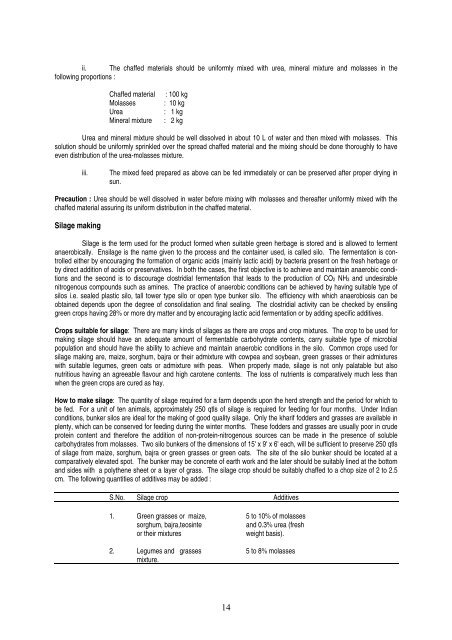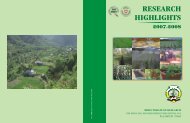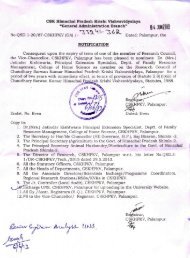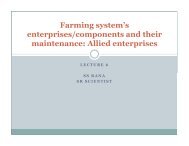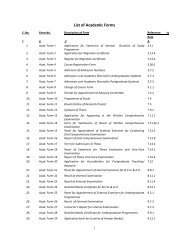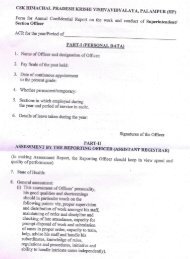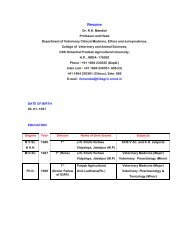animal production - CSK Himachal Pradesh Agricultural University ...
animal production - CSK Himachal Pradesh Agricultural University ...
animal production - CSK Himachal Pradesh Agricultural University ...
You also want an ePaper? Increase the reach of your titles
YUMPU automatically turns print PDFs into web optimized ePapers that Google loves.
ii. The chaffed materials should be uniformly mixed with urea, mineral mixture and molasses in the<br />
following proportions :<br />
Chaffed material : 100 kg<br />
Molasses : 10 kg<br />
Urea : 1 kg<br />
Mineral mixture : 2 kg<br />
Urea and mineral mixture should be well dissolved in about 10 L of water and then mixed with molasses. This<br />
solution should be uniformly sprinkled over the spread chaffed material and the mixing should be done thoroughly to have<br />
even distribution of the urea-molasses mixture.<br />
iii. The mixed feed prepared as above can be fed immediately or can be preserved after proper drying in<br />
sun.<br />
Precaution : Urea should be well dissolved in water before mixing with molasses and thereafter uniformly mixed with the<br />
chaffed material assuring its uniform distribution in the chaffed material.<br />
Silage making<br />
Silage is the term used for the product formed when suitable green herbage is stored and is allowed to ferment<br />
anaerobically. Ensilage is the name given to the process and the container used, is called silo. The fermentation is controlled<br />
either by encouraging the formation of organic acids (mainly lactic acid) by bacteria present on the fresh herbage or<br />
by direct addition of acids or preservatives. In both the cases, the first objective is to achieve and maintain anaerobic conditions<br />
and the second is to discourage clostridial fermentation that leads to the <strong>production</strong> of CO2 NH3 and undesirable<br />
nitrogenous compounds such as amines. The practice of anaerobic conditions can be achieved by having suitable type of<br />
silos i.e. sealed plastic silo, tall tower type silo or open type bunker silo. The efficiency with which anaerobiosis can be<br />
obtained depends upon the degree of consolidation and final sealing. The clostridial activity can be checked by ensiling<br />
green crops having 28% or more dry matter and by encouraging lactic acid fermentation or by adding specific additives.<br />
Crops suitable for silage: There are many kinds of silages as there are crops and crop mixtures. The crop to be used for<br />
making silage should have an adequate amount of fermentable carbohydrate contents, carry suitable type of microbial<br />
population and should have the ability to achieve and maintain anaerobic conditions in the silo. Common crops used for<br />
silage making are, maize, sorghum, bajra or their admixture with cowpea and soybean, green grasses or their admixtures<br />
with suitable legumes, green oats or admixture with peas. When properly made, silage is not only palatable but also<br />
nutritious having an agreeable flavour and high carotene contents. The loss of nutrients is comparatively much less than<br />
when the green crops are cured as hay.<br />
How to make silage: The quantity of silage required for a farm depends upon the herd strength and the period for which to<br />
be fed. For a unit of ten <strong>animal</strong>s, approximately 250 qtls of silage is required for feeding for four months. Under Indian<br />
conditions, bunker silos are ideal for the making of good quality silage. Only the kharif fodders and grasses are available in<br />
plenty, which can be conserved for feeding during the winter months. These fodders and grasses are usually poor in crude<br />
protein content and therefore the addition of non-protein-nitrogenous sources can be made in the presence of soluble<br />
carbohydrates from molasses. Two silo bunkers of the dimensions of 15' x 9' x 6' each, will be sufficient to preserve 250 qtls<br />
of silage from maize, sorghum, bajra or green grasses or green oats. The site of the silo bunker should be located at a<br />
comparatively elevated spot. The bunker may be concrete of earth work and the later should be suitably lined at the bottom<br />
and sides with a polythene sheet or a layer of grass. The silage crop should be suitably chaffed to a chop size of 2 to 2.5<br />
cm. The following quantities of additives may be added :<br />
S.No. Silage crop Additives<br />
1. Green grasses or maize, 5 to 10% of molasses<br />
sorghum, bajra,teosinte and 0.3% urea (fresh<br />
or their mixtures weight basis).<br />
2. Legumes and grasses 5 to 8% molasses<br />
mixture.<br />
14


